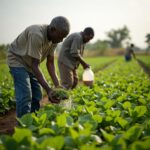Biogas is an abundant cheapest fuel derived from the anaerobic digestion of biological matters ranging from cow dung, pig dung, poultry droppings, human waste (Night soil) and food waste materials.
The breakdown of organic materials, such as food leftovers and animal feces, produces biogas, a renewable fuel. It can be used to generate energy, heat, and fuel for automobiles, among other things.
How is biogas produced?
Biogas is a renewable energy source that is good for the environment.
It is created when bacteria break down organic materials, like food or animal waste, without oxygen. This process is known as anaerobic digestion. The waste material must be contained in an oxygen-free environment for this to happen.
Intentionally producing biogas for fuel can happen naturally or as part of an industrial process.
What sort of waste can be used to produce biogas?
A wide variety of organic waste material breaks down into biogas, including animal manure, municipal rubbish/ waste, plant material, food waste or sewage.
Which gases does biogas contain?
Biogas consists mainly of methane and carbon dioxide. It can also include small amounts of hydrogen sulphide, siloxanes and some moisture. The relative quantities of these vary depending on the type of waste involved in the production of the resulting biogas.
What can biogas be used for?
To power our generator – the methane generated from the biogas is used to buy our generator.
As a replacement for natural gas – the methane is a source of free cooking gas for household & businesses.
As a liquid fertilizer for farms- The effluent/discharge out of the plant can be used as organic fertilizer for farms.
What is biofil system?
A biofill digester (biological filter digester) is a sanitation technology that combines aerobic digestion with soil filtration. Human waste is broken down by aerobic bacteria in a sealed chamber, and treated effluent is filtered through layers of gravel and fiber, allowing clean water to percolate into the surrounding soil.
Differences between biofil digester and traditional manhole (soakaway)?
A biofill digester is a waste management system that was designed to eliminate the flaws of the normal manhole (which is popularly called soak-away)
A manhole consists of two sides; the septic side and the soak-away side. The septic side takes the feaces. This is where all your flushed excrete goes into. The soak-away is the side that takes all the waste water and then percolate (soaks) into soil. That is why it is called soak-away



